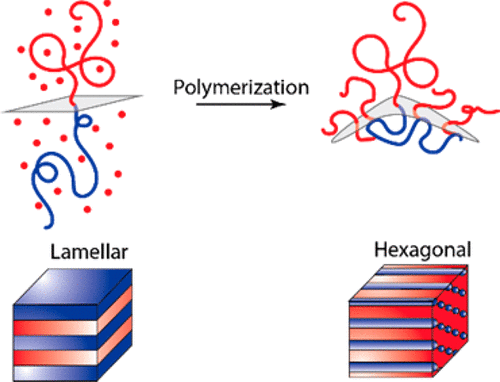当前位置:
X-MOL 学术
›
ACS Macro Lett.
›
论文详情
Our official English website, www.x-mol.net, welcomes your
feedback! (Note: you will need to create a separate account there.)
Polymerization-Induced Nanostructural Transitions Driven by In Situ Polymer Grafting
ACS Macro Letters ( IF 5.1 ) Pub Date : 2018-06-22 00:00:00 , DOI: 10.1021/acsmacrolett.8b00378 Everett S. Zofchak , Jacob A. LaNasa , Wenwen Mei , Robert J. Hickey
ACS Macro Letters ( IF 5.1 ) Pub Date : 2018-06-22 00:00:00 , DOI: 10.1021/acsmacrolett.8b00378 Everett S. Zofchak , Jacob A. LaNasa , Wenwen Mei , Robert J. Hickey

|
Polymerization-induced structural transitions have gained attention recently due to the ease of creating and modifying nanostructured materials with controlled morphologies and length scales. Here, we show that order–order and disorder–order nanostructural transitions are possible using in situ polymer grafting from the diblock polymer, poly(styrene)-block-poly(butadiene). In our approach, we are able to control the resulting nanostructure (lamellar, hexagonally packed cylinders, and disordered spheres) by changing the initial block polymer/monomer ratio. The nanostructural transition occurs by a grafting from mechanism in which poly(styrene) chains are initiated from the poly(butadiene) block via the creation of an allylic radical, which increases the overall molecular weight and the poly(styrene) volume fraction. The work presented here highlights how the chemical process of converting standard linear diblock copolymers to grafted block polymers drives interesting and controllable polymerization-induced morphology transitions.
中文翻译:

原位聚合物接枝驱动的聚合诱导纳米结构转变
由于易于创建和修改具有受控形态和长度尺度的纳米结构材料,聚合诱导的结构转变最近引起了人们的关注。在这里,我们表明使用二嵌段聚合物聚(苯乙烯)嵌段的原位聚合物接枝可以实现有序和无序纳米结构转变-聚(丁二烯)。在我们的方法中,我们能够通过改变初始嵌段聚合物/单体的比例来控制产生的纳米结构(层状、六角形堆积圆柱体和无序球体)。纳米结构转变通过接枝机制发生,其中聚(苯乙烯)链通过产生烯丙基自由基从聚(丁二烯)嵌段引发,这增加了总分子量和聚(苯乙烯)体积分数。这里介绍的工作强调了将标准线性二嵌段共聚物转化为接枝嵌段聚合物的化学过程如何驱动有趣且可控的聚合诱导的形态转变。
更新日期:2018-06-22
中文翻译:

原位聚合物接枝驱动的聚合诱导纳米结构转变
由于易于创建和修改具有受控形态和长度尺度的纳米结构材料,聚合诱导的结构转变最近引起了人们的关注。在这里,我们表明使用二嵌段聚合物聚(苯乙烯)嵌段的原位聚合物接枝可以实现有序和无序纳米结构转变-聚(丁二烯)。在我们的方法中,我们能够通过改变初始嵌段聚合物/单体的比例来控制产生的纳米结构(层状、六角形堆积圆柱体和无序球体)。纳米结构转变通过接枝机制发生,其中聚(苯乙烯)链通过产生烯丙基自由基从聚(丁二烯)嵌段引发,这增加了总分子量和聚(苯乙烯)体积分数。这里介绍的工作强调了将标准线性二嵌段共聚物转化为接枝嵌段聚合物的化学过程如何驱动有趣且可控的聚合诱导的形态转变。











































 京公网安备 11010802027423号
京公网安备 11010802027423号